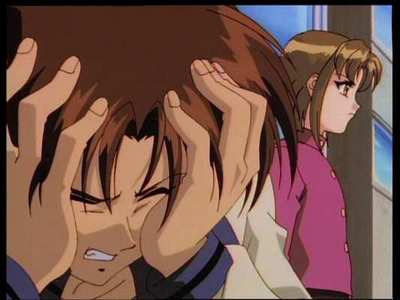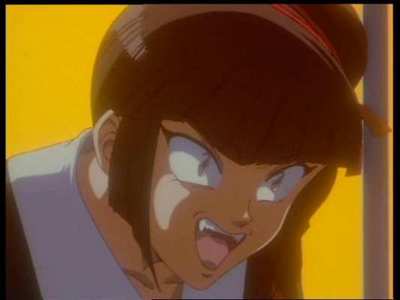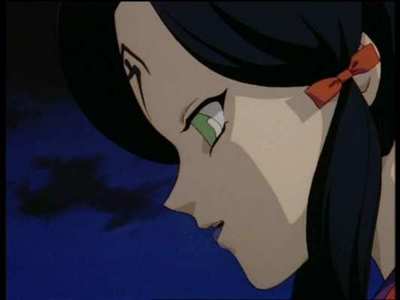Review of Vampire Princess Miyu: Vol. 2
Introduction
Here I am, reviewing a title that has been deleted in the UK. It`s not just from the narcissistic pleasure of seeing my own words lighting up the odd PC screen, as there are still plenty of copies to be had from retailers. Incidentally, I got my maths wrong with volume 1. Miyu is a 26 episode series, not 24, so while volume 1 has only 3 episodes, volumes 2 and 3 have 4 apiece, while the remainder have 5 episodes each.
Shinma are supernatural beings that corrupt the hearts of men and lead them to ruin. Banished in ancient times to the Darkness, a few stray Shinma remain wreaking havoc on unsuspecting individuals. But there is a Guardian to defend us, the Vampire Princess Miyu, a Shinma herself who hunts down these monsters and sends them to the beyond. Larva, a Shinma from the West who acts as her protector, and Shiina, a small creature who acts as her adviser, help her in her duties. An enigmatic figure called Reiha also hunts stray Shinma, but it`s unclear if she is an ally or enemy to Miyu. By day, Miyu masquerades as a schoolgirl, and has even made friends, Chisato, Hisae and Yukari, but finds trying to live a normal life interferes with her calling.
The four episodes on this disc comprise Reiha Has Come, Sepia Coloured Portrait, Ghost Of Miyu, and Fate.

Video
Vampire Princess Miyu is presented with a 4:3 format. The transfer is clear enough, with a sharp image and good colours throughout. The animation is variable, occasionally very good and atmospheric, but sometimes the minimalism associated with anime is taken too far, with a few scenes a little too static. By and large the character design is also top-notch, but there are a few points where things look a little under par.

Audio
You get DD 2.0 English and Japanese soundtracks on this disc, and while the stereo is understated, it is evocative and certainly establishes the otherworldly feel of the stories. The atmospheric music is a big part of this, coming from the composer of the Ghost In The Shell movies, Kenji Kawai.
As usual I chose the original Japanese soundtrack, but I did dip my metaphorical toes into the dubbed version. The dub isn`t the usual travesty (although the main character does sound a little somnolent), and the English track does come across as just a tad crisper than the Japanese. The subtitles are of the translated English variety.
There are a couple of moments 19 minutes into the first episode where the Japanese stereo momentarily degrades into mono, and 51 minutes into the programme where the sound drops out completely but neither of these incidences last long, and they don`t impact on any dialogue.

Features
Extras on this disc include the original Japanese title sequence, as well as a Shinma gallery, which has six line sketches of the Shinma encountered in the episodes. While the first disc presented three episodes as one hour long film, this disc sees the credit sequences restored, indeed, the end credits are repeated twice, once in Japanese and once in English.

Conclusion
It quickly becomes apparent that Vampire Princess Miyu is an older anime, it`s determinedly hand-animated, and rather subdued and economic at that. But it`s not only the look of the piece. It very much has an older outlook to it, and compared to modern anime, the writing isn`t as sharp, the characters a little clichéd, and it`s quite episodic in nature. But an episodic anime also has a certain appeal to it, the perfect thing to watch when you feel like a one night stand instead of a long-term relationship. It can best be described as a monster of the week show, with Miyu having to face a new Shinma each week. But rather than following a Scooby Doo routine, the stories are quite varied, and the monsters are imaginatively thought out and executed. I always feel that Vampire Princess Miyu has a touch of the X Files about it, and that can`t be a bad thing.
There is a hint of an over reaching story to the show, one that really manifests in the final volume, but the plot points and important characters are introduced early on. The first episode here begins with the introduction of Reiha, a young girl with a strange sigil marked on her forehead. Her constant companion is a doll named Matsukaze, who advises her, and is in some ways the manifestation of her darker nature. For like Miyu, Reiha is a demon that hunts and destroys Shinma. Unlike Miyu however, Reiha is cold and clinical, uncaring about the humans that get in the way. It also becomes apparent that Reiha nurses a hefty grudge when it comes to Miyu, and is more threat than ally. Her heartlessness is revealed in the first episode when Miyu has to deal with a Shinma that has been tricking humans, and turning them into animals. While Miyu can confront the Shinma, it turns out that the humans are her weakness, and is shocked when Reiha deals with the duped humans so harshly.
The second episode, quite reminiscent of The Ring, involves a student film that has a demon existing inside the reel. The man who made the film cherishes it, as it reminds him of a lost love, a time when he was younger and when his life was perfect. He knows that the film consumes those that watch it, but he can`t bring himself to destroy it. Ghost Of Miyu sees our vampiric heroine targeted. There is a doppelganger loose, one that is preying on unsuspecting taxi drivers, and when rumours begin to circulate in school, Miyu finds herself under unwelcome scrutiny. The final episode turns out to be the best on the disc, with Miyu encountering a couple of unique orphans. A brother who is telepathic and a sister who is telekinetic, fearing their powers being discovered have run away from their care home. The boy has trouble screening out the thoughts around him, while his sister acts precipitously when she sees him in pain. But he can`t read Miyu`s thoughts, and the three strike up a friendship. Miyu sees herself in the young girl, and wishes to help them, but then a Shinma gets involved.
The recurring theme of Vampire Princess Miyu is that humans and the supernatural just don`t mix. As a result, bittersweet endings are the norm here. When the most favourable outcome is that of Miyu drinking the blood of a victim to give eternal bliss, then it isn`t surprising that the show has a bleak tone to it. It seems that it is a lesson that Miyu has to relearn, as she keeps getting involved with humans, and they wind up suffering as a consequence. It`s only her school friends who come out of these episodes relatively unscathed. Miyu is a reluctant guardian, she keeps speaking of her duties as a burden, a curse, and it appears that she would rather have a normal life. And so the cycle of hope and disappointment keeps repeating.
The darker outlook of the show is a definite draw, as is the variety in the stories. We can go from a simple good guy bad guy dynamic as in Ghost Of Miyu, to something quite bittersweet and melancholy as in Sepia Coloured Portrait. The negative to the show would be the supporting cast, especially Miyu`s schoolmates. Chisato is her best friend, and with them are Yukari and Hisae, and when the story focuses on their friendship it`s certainly interesting. It`s when Yukari, Chisato and Hisae set themselves up as amateur ghostbusters that things become a little ridiculous. School kids investigating the supernatural, with convenient reference material in the school library just smacks of Scooby Doo a little too much. Their suspicions of Miyu are never raised, despite having odd occurrences happen right in front of them, as when Miyu`s look-alike walks into school, and the two confront each other. But this isn`t a fatal flaw.
Vampire Princess Miyu is definitely old school anime, but there is something to be said for a show that can be savoured in bite-sized pieces. And at the price that it is now available for in certain online boutiques, it would be rude not to.
Your Opinions and Comments
Be the first to post a comment!